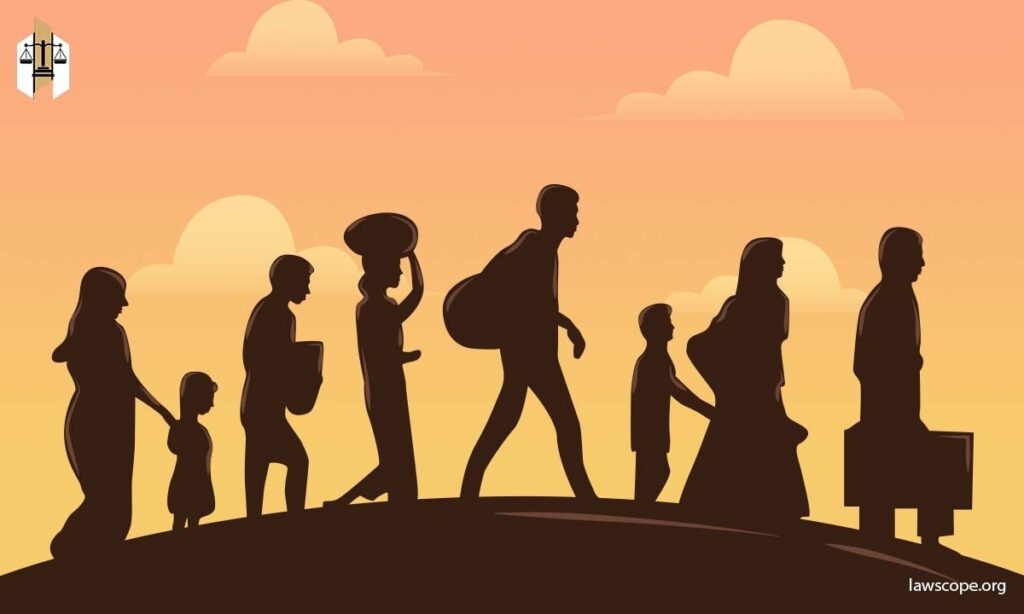
Significant movements of people, fleeing conflict, persecution and humanitarian crises in search of safety and refuge, mark the global landscape.
Nations grapple with formulating policies for refugees and asylum seekers as they strive to balance security concerns against humanitarian imperatives.
Addressing the needs of displaced populations inherently involves complexities that demand thoughtful consideration; and international cooperation; furthermore a steadfast commitment to upholding human rights is indispensable.
Understanding Refugee and Asylum Concepts
Distinction and interconnectedness characterize both refugees and asylum seekers as groups that require international law protection.
A refugee refers to an individual who, fearing persecution based on race, religion, nationality, political opinion or membership in a specific social group within their home country’s boundaries; flee these threats by leaving their native land.
On the other hand–an asylum seeker represents someone seeking shelter in another nation without holding official status of refuge yet granted to them. Both groups seek safety and security from violence, conflict, and persecution.
Expert Legal Guidance and Representation
One of the primary functions of a immigration lawyer is to provide expert legal guidance and representation to individuals facing immigration challenges.
From visa applications and residency permits to asylum claims and deportation proceedings, immigration lawyers offer personalized advice and strategic advocacy tailored to the unique circumstances of each client.
International Obligations and Legal Frameworks
International legal frameworks, such as the 1951 Refugee Convention and its 1967 Protocol, govern the protection of refugees and asylum seekers.
These instruments establish a nation’s rights and responsibilities towards these individuals: they outline principles like non-refoulement—a prohibition against returning someone to a country where persecution awaits them—and an unprejudiced right to seek asylum.
Refugee Resettlement and Asylum Procedures
Refugee resettlement programs offer a pathway to permanent homes in host countries, which not only provide protection but also opportunities for integration.
The process of resettlement ensures the safety and security of both refugees and their future host communities through meticulous screening, vetting, and selection procedures.
Procedures for asylum differ across nations; they might encompass interviews, asylum hearings – as well as appeals processes – all aimed at establishing eligibility for protective measures.
Challenges and Complexities
Challenges and complexities inherently accompany the implementation of refugee and asylum policies.
Host countries, in discharging their duties towards humanity, face a delicate equilibrium between these international commitments and domestic priorities such as national security concerns; utilization of public resources—alongside maintaining social cohesion is paramount.
An influx of refugees or asylum seekers may overburden infrastructure systems like social services: this could potentially stir up tensions among local communities leading to perceived resentment from host populations.
Addressing Root Causes and Providing Sustainable Solutions
Essential to resolving the global refugee crisis is a proactive approach that addresses the root causes of forced displacement.
By fostering conditions conducive for refugees’ voluntary return and sustainable reintegration into their home countries, we can make significant progress.
This involves implementing conflict resolution strategies, peacebuilding efforts and developmental initiatives.
Equally critical are international cooperation; robust support for humanitarian assistance, protection of refugees; and formulation long-term solutions – all necessary steps towards addressing underlying drivers behind displacement.
Protection Gaps and Vulnerable Populations
Women, children, the elderly and persons with disabilities: specific populations whose vulnerability to displacement is particularly high.
They confront unique protection challenges–a reality we must acknowledge. In refugee settings specifically, pervasive threats exist such as gender-based violence; child trafficking and exploitation pose significant risks; hence it becomes imperative for targeted interventions along with specialized services to address these specific needs of our most vulnerable groups.
Upholding Human Rights and Dignity
A commitment to uphold human rights and dignity for all individuals, independent of their migration status, is pivotal in effective refugee and asylum policies.
Essential components for promoting the well-being as well as self-reliance of refugees or asylum seekers include: access to legal representation; psychosocial support; education opportunities – both formal and informal; healthcare provisions – not limited but comprehensive—and livelihood opportunities.
Building Inclusive and Resilient Communities
Fostering the inclusion and integration of displaced populations into host communities, successful refugee and asylum policies promote social cohesion, diversity, and resilience.
Community-based initiatives such as cultural exchange programs; along with interfaith dialogue – can bridge divides among diverse populations: these efforts are fundamental to fostering understanding.
Collaboration and Burden-Sharing
Nations, international organizations, civil society groups and other stakeholders must collaborate and share the burden to address the global refugee crisis.
This involves sharing responsibility for protection of refugees as well as their resettlement and integration; such actions not only alleviate strain on host countries but also foster solidarity and cooperation globally.
Humanitarian Aid and Assistance
To meet the immediate needs of displaced populations – shelter, food, water and healthcare; providing humanitarian aid and assistance is essential.
Lifesaving assistance delivery, advocating for refugee rights: these are critical roles that humanitarian organizations play–they also raise awareness about challenges faced by refugees.
Education and Empowerment
Fundamental human rights and key determinants of long-term well-being: education–a fundamental human right; self-reliance–a determinant.
Promoting social inclusion, empowering individuals to build brighter futures, contributing to the development of resilient communities–accessing quality education for refugee children and youth accomplishes all these.
Legal Protections and Access to Justice
For safeguarding the rights of refugees and asylum seekers, it is crucial to ensure their access to legal protections and mechanisms for seeking justice.
Services like legal aid, asylum procedures, and judicial oversight not only protect individuals from arbitrary detention or discrimination but also guarantee them fair treatment under transparent law — thus preventing undue deportations effectively.
Advocacy and Awareness-Raising
Mobilizing public support for refugee protection and rights hinges critically on advocacy efforts: these – alongside awareness raising initiatives – are key.
Advocates can galvanize diverse communities, as well as policymakers; by amplifying refugees’ voices, sharing their narratives– thereby challenging misconceptions and stereotypes.
This approach fosters not only empathy but also understanding and solidarity in its wake.
Innovation and Technology
Innovative approaches and technologies: these are key tools that can address the unique challenges imposed by forced displacement; they also enhance the effectiveness of refugee and asylum policies.
Digital platforms, data analytics–even biometric identification systems–play a pivotal role in facilitating registration, documentation, tracking for refugees; this improvement directly translates to better service delivery as well as increased accountability within humanitarian response efforts.
Long-Term Solutions and Sustainable Development
Essential for the addressal of underlying drivers that force displacement – poverty, inequality and environmental degradation: investing in sustainable development initiatives and long-term solutions.
By striving towards access to education; healthcare; clean water–as well as economic opportunities—we can create conditions conducive to refugees rebuilding their lives with dignity, resilience – all while promoting our own growth.
Empowering Local Communities
Fostering social cohesion and mutual support requires empowering local communities to actively engage in refugee protection and integration.
Through community-based initiatives, volunteer programs, and cultural exchange activities—diverse populations cultivate understanding—as well as solidarity; they fortify bonds of empathy and cooperation against adversity.
Legal Protections and Access to Justice
Safeguarding the rights of refugees and asylum seekers necessitates ensuring their access to legal protections and justice-seeking mechanisms.
Services such as legal aid, asylum procedures, and judicial oversight mechanisms safeguard individuals from arbitrary detention, deportation, discrimination; they guarantee fair–even transparent–treatment under the law.
Conclusion
A multifaceted and compassionate response rooted in human rights principles, solidarity, and international cooperation is necessary to address the challenges of forced displacement.
Nations can steer through the complexities of refugee and asylum policies while maintaining their humanitarian obligations in an uncertain world by championing refugees’ rights and dignity; investing in sustainable solutions; as well as fostering inclusive resilient communities.
You May Like Also:

